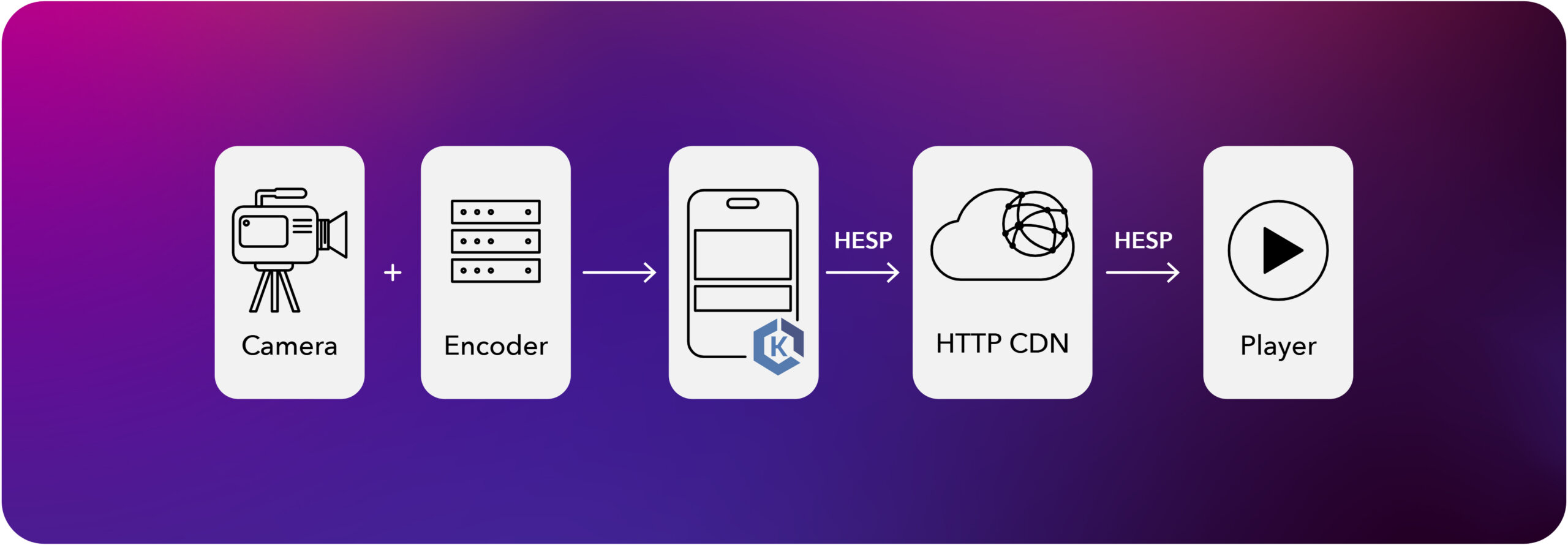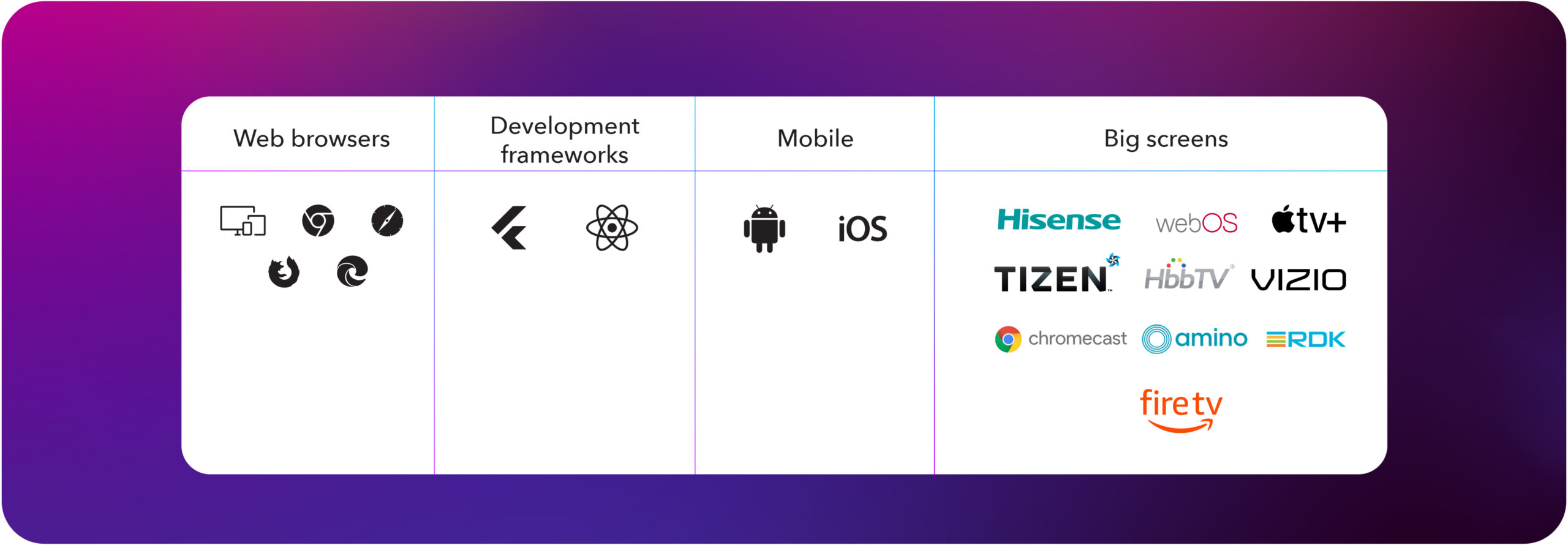As the demand for real-time streaming has grown, the technology used to support these efforts has been forced to evolve to meet these demands.
HESP is one of the robust streaming protocols developed to support real-time streaming. This technology was designed to prioritize simplicity, reduce overhead, and improve performance.
In this article, we will discuss HESP and why it’s crucial for OTT broadcasting. We’ll also cover how it works and which use cases this protocol suits best. Finally, we will take a quick look at some other valuable protocols for modern streaming use cases.
What is HESP?
The High-Efficiency Streaming Protocol (HESP) is an HTTP Adaptive Streaming Protocol (HAS) designed to support high-quality video streaming over the internet. It offers a true broadcast-like video streaming experience combined with advanced interactivity.
This protocol was engineered by THEO Technologies, which is now known as Dolby OptiView, and distributed by the HESP Alliance. THEO began developing the technology in 2018, and it was launched to the public in 2020.
The purpose of developing HESP was to:
- Significantly reduce latency to allow for sub-second latency
- Shorten zapping times to about 100ms to allow for similar to traditional broadcast experiences
- Bring down bandwidth costs for broadcasters and optimize viewer bandwidth usage up to 20%
- Remain scalable using HTTP CDNs, allowing for virtually endless scaling in a cost-efficient manner
Fortunately, HESP has proven successful on all fronts.

Benefits of HESP
There are several benefits to using HESP to support your streams, including enhancing the user experience, improving compatibility with other streaming technologies, and more. Let’s take a moment to review these benefits more closely.
Improves the user experience
One of the most valuable aspects of HESP is that it improves the user experience. It is particularly valuable for setting up interactive streaming experiences where viewers can engage with the streamed content in near real-time.
Plus, since it provides an ultra-fast zapping time of only 100ms, it boosts user engagement by providing instant video startup when zapping between channels.
Interoperable with most CDNs
The HESP protocol was designed to be interoperable with third-party CDNs. That is because the protocol is designed to require only HTTP/1.1 features and capabilities, similar to CMAF-CTE.
The HTTP capabilities required to use HESP in combination with a CDN include support for:
- HTTP chunked
- Transfer encoding
- HTTP range requests
This criteria is a very low technical requirement, so most third-party CDNs should clear this threshold with no issue.
Depending on the CDN, the additional latency introduced by a CDN varied around 50ms, keeping the total end-to-end latency well below one second.
Capable of adaptive bitrate (ABR) streaming
The HESP protocol is designed to support adaptive bitrate streaming. This allows immediate switching to alternative renditions so the stream can adapt to varying viewer network conditions.
HESP players are capable of measuring the used and available bandwidth within the client by fingerprinting the current network traffic. Based on this information and other viewer environment metadata, such as device orientation or resolution, the client’s device can switch to a rendition better suited to the current environment.
When using the HESP protocol, an ABR switch can be made immediately and does not need to be timed with certain intervals. This is in contrast with HAS protocols and CMAF-CTE, where switches to alternative renditions can only be made on the edge of a segment. Since HESP can switch renditions immediately, this significantly reduces the risk of stalling and buffering behavior.
This aspect is less significant when the choice would be to switch towards a higher quality and bitrate rendition due to a bandwidth increase. However, it’s crucial to immediately switch to a lower bitrate rendition in case of a bandwidth reduction to avoid buffering. This is especially true when the goal is low-latency playback since you want to keep the playback buffer as small as possible.
Highly compatible for facilitating cross-platform delivery
Another major perk of HESP is that it is highly compatible with the most popular platforms and devices, making it a great option if you’re aiming to implement a cross-platform playback strategy. This includes a few platforms that are not accessible with other streaming protocols.
In order to achieve this, both native and HTML5-based HESP players were developed. With that said, HESP supports a wide variety of platforms and devices, including the following and more:
- iOS, tvOS, and Safari (including mobile Safari on iOS)
- Android and Android TV (on smart TV and specific STBs)
- Chrome and Chromecast
- Firefox
- Edge

Top use cases for HESP
HESP is very valuable in use cases where the goal is to minimize latency as much as possible. Some of the most common use cases for HESP include:
- iGaming and casino live streaming
- Live sports betting
- Sporting events
- Online auctions
- Two-way conferencing (education, telehealth, webinars, etc.)
Thanks to its broad compatibility, HESP is also an option for cross-platform streaming, even if ultra-low latency is not the goal.
How HESP works: a technical overview
Knowing how HESP works from a technical perspective is valuable for understanding how it can fit into your streaming workflow.
HESP is delivered over HTTP/1.1 and uses Chunked Transfer Encoding (CTE) at a minimal granularity. This means each chunk contains a frame to allow for very low-latency streaming. Plus, since this protocol uses byte range requests to allow playback to start at a given position in the video, it has a reduced start-up latency.
HESP relies on two complementary streams to achieve its astonishing results: an initialization stream and a continuation stream.
The initialization stream contains only key frames and is used when a new stream starts. At that moment, the most recent image available in the initialization stream (or another image if starting at a different timestamp in the stream) is requested.
Playback can start immediately since the initialization stream’s images are key frames. Key frames are expensive in terms of bandwidth, so it is important to stop playing out the following images from the initialization stream. This is where the continuation stream kicks in.
The continuation stream is a regularly encoded stream for low-latency purposes. Images from the continuation stream are requested using a byte range request, starting at a precise location (the image following the image fetched from the initialization stream). The start position of the byte range request is sent alongside the initialization stream’s image.
If the viewer wants to change channels and watch a different stream, the player requests the second video feed’s most recent initialization frame. The continuation stream will be picked up for the remainder of the second stream, as we described above.
This overview is a bit technical, so if you’d like to better understand how this technology can fit into your streaming workflow, contact us, and a member of our team will reach out to discuss it.

HESP alternatives to consider
While HESP is a robust streaming protocol, it is simply one of several that support the streaming industry today.
WebRTC is another excellent option if your goal is real-time streaming. It is free, open-source, and backed by many of the top tech companies on the market. This makes it ideal for developers. It is especially well-suited for use cases requiring imperceptible screen-to-screen latency, like video conferencing.
RMTP and HLS are also great options, but they are not capable of streaming at as low a latency as HESP and WebRTC.
Final thoughts
HESP is an excellent protocol for delivering streams in real time. It provides a high-quality user experience while saving broadcasters’ bandwidth costs. Plus, it’s highly compatible with other crucial elements in the streaming process, like CDNs and various streaming devices.
If you’re looking for a solution to support your sub-second streaming objectives, Dolby OptiView is here to help. Whether you’re looking for a powerful video player or an end-to-end streaming solution, we’ve got you covered. Contact us today to learn more.








